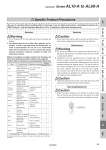
es40-56-ac 70 / 88
10秒後にBOOKのページに移動します
68 Lubricator Series AL10-A to AL60-A AW AL AR AFM / AFD AF Attachment AW+AFM AF+AFM+AR AF+AR AW+AL AF+AR+AL AC Lock button Specific Product Precautions Selection Selection Be sure to read this before handling. Refer to the back cover for Safety Instructions, “Handling Precautions for SMC Products” and the Operation Manual for F.R.L. Precautions, http://www.smcworld.com Warning 1. Do not introduce air from the outlet side as this can damage the bumper. 2. The standard bowl for the air filter, filter regulator, and lubricator, as well as the sight dome for the lubricator are made of polycarbonate. Do not use in an environment where they are exposed to or come in contact with organic solvents, chemicals, cutting oil, synthetic oil, alkali, and thread lock solutions. Maintenance Caution 1. Use a check valve (Series AKM) to prevent back flow of the lubricant when redirecting the air flow before the lubricator. Warning 1. For the AL10-A/AL20-A type, replenish the lubricant after releasing the inlet pressure. Lubrication cannot take place under a pressurized condition. 2. Adjustment of the oil regulating valve for models from the AL20-A to AL60-A should be carried out manually. Turning it counterclockwise increases the dripping amount, and turning it clockwise reduces the dripping amount. The use of tools etc. can result in damage to the unit. From the fully closed position, three rotations will bring it to the fully open position. Do not rotate it any further than this. Note that the numbered scale markings are guidelines for adjusting the position, and not indicators of the dripping amount. 1. Check the dripping amount once a day. Drip failure can cause damage to the components that need lubrication. Mounting/Adjustment 1. When the bowl is installed on the AL30-A to AL60-A, install them so that the lock button lines up to the groove of the front (or the back) of the body to avoid drop or damage of the bowl. Caution Caution When the above factors are present, or there is some doubt, use a metal bowl for safety. Effects of atmosphere of organic solvents and chemicals, and where these elements are likely to adhere to the equipment. Chemical data for substances causing degradation (Reference) Type Chemical name Application examples Material Polycarbonate Nylon Acid Hydrochloric acid Sulfuric acid, Phosphoric acid Chromic acid Acid washing liquid for metals 寱 u Alkaline Sodium hydroxide (Caustic soda) Potash Calcium hydroxide (Slack lime) Ammonia water Carbonate of soda Degreasing of metals Industrial salts Water-soluble cutting oil 𡵅 屧 Inorganic salts Sodium sulfide Sulfate of potash Sulfate of soda . 𡵅 寱 Chlorine solvents Carbon tetrachloride Chloroform Ethylene chloride Methylene chloride Cleansing liquid for metals Printing ink Dilution 𡵅 寱 Aromatic series Benzene Toluene Paint thinner Coatings Dry cleaning 𡵅 寱 Ketone Acetone Methyl ethyl ketone Cyclohexane Photographic film Dry cleaning Textile industries 𡵅 u Alcohol Ethyl alcohol IPA Methyl alcohol Antifreeze Adhesives 寱 u Oil Gasoline Kerosene . 𡵅 屧 Ester Phthalic acid dimethyl Phthalic acid diethyl Acetic acid Synthetic oil Anti-rust additives 𡵅 屧 Ether Methyl ether Ethyl ether Brake oil additives 𡵅 屧 Amino Methyl amino Cutting oil Brake oil additives Rubber accelerator 𡵅 u Others Thread-lock fluid Seawater Leak tester . 𡵅 寱 屧: Essentially safe 寱: Some effects may occur. 𡵅: Effects will occur.